SapphireOne Accounts Receivables Report Tutorial: The Client Details Report
December 11, 2020 12:00 pm | by John Adams

Creating an Accounts Receivables Client Details Report in SapphireOne
SapphireOnes Accounts Receivables Report functionality allows you to produce a variety of reports based on templates that have been designed in SapphireOne.
The Accounts Receivables reporting functionality includes six different types of reporting options, these are:
- Details
- Balances
- Transactions
- Statements
- Show Reports
- Dashboards
Each Accounts Receivables report allows you to report dynamically on multiple client data fields for a variety of purposes.
The aim of the Accounts Receivables Reporting Tutorials is to take you through each of the six reports, so you can learn how to create and when to use each report, and stay up-to-date on all SapphireOne’s reporting capabilities.
The Client Details Report
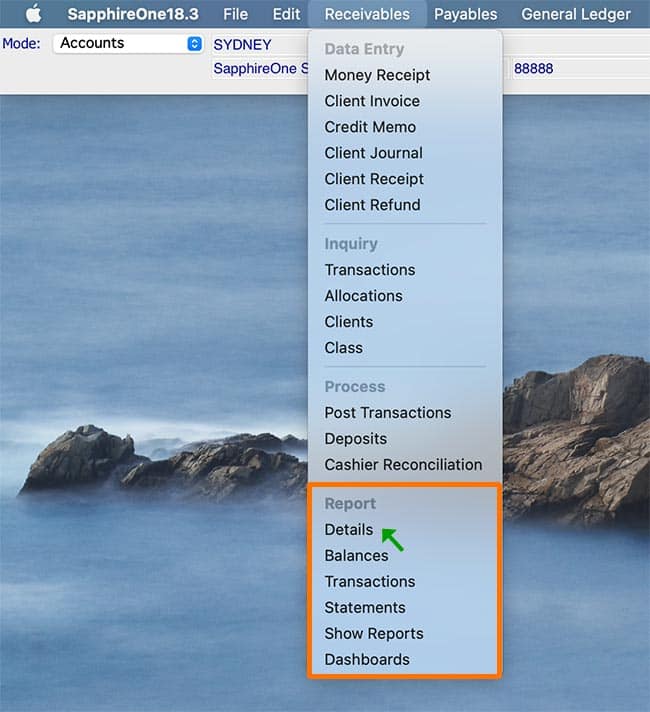
The first of the Accounts Receivables reporting options in SapphireOne is the Client Details Report.
The Client Details Report gives you the ability to report on your clients contact details using a variety of defined data fields. You have the option to choose from 9 reporting types, each allowing you to generate reports on different client contact information.
When selecting the Client Details Report, you are presented with a print dialog pop-up enabling the selection of items required in the report. You have the option to select which Detail you would like to report on from a variety of reporting types.
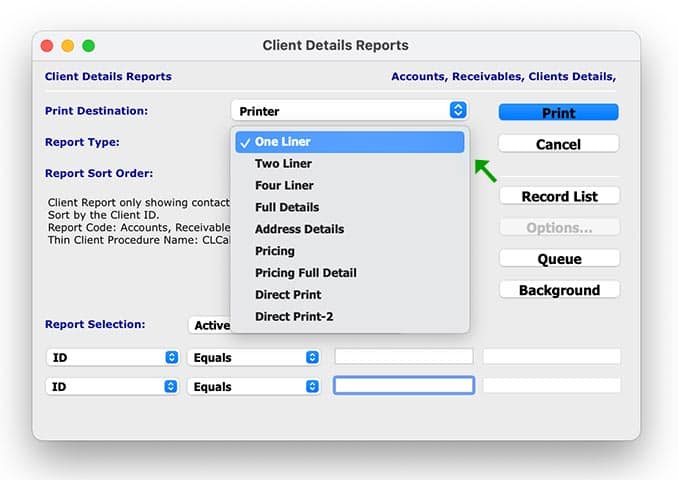
Below is an overview of each Client Details Report Type, and what each report can be used for:
- One Liner – This is a simple report showing ID, Name, Contact, Position and Phone details.
- Two Liner – This report expands on the above report with additional Contact details for the nominated Client.
- Four Liner – This report expands again on the Two Liner and gives Postal and Physical Address details.
- Full Details – This report gives ALL details about each Client. There are two to a page unless there are too many notes or keywords for a Client.
- Address Details – This report gives details of the Multiple Addresses set up for each of the clients.
- Pricing – This report includes Price Book Information.
- Pricing Full Details – This report includes Price Book information and Client information.
- Direct Print – This report allows for the use of Direct Print layout as set up in Utilities. Within SapphireOne you can navigate to Utilities/Controls/Direct Print Layouts to define this.
- Direct Print 2 – This report allows for the use of another Direct Print layout option as set up in Utilities. Within SapphireOne you can navigate to Utilities/Controls/Direct Print Layouts to define this.
In the Report Selection menu drop-down, you can select the All Records option to print details for all Clients instead of only the Active Only Clients.
Once you have chosen your defined report details, and selected Print, you have the option to open the report as a PDF or print the report directly from SapphireOne.
Any questions?
Stay tuned for the next blog post in our next Accounts Receivables Reporting Tutorials, where we dig into the Balances Report.
For more information on Accounts Receivables Reports, or to find out how you can get more out of your SapphireOne application, please contact us or book a call with a member of our Support Team. We love hearing from you!
Are You Ready for Payroll Year End?
June 16, 2020 11:20 am | by John Adams

Preparing and processing your Payroll Year End only takes 8 simple steps and by following them closely, you will smoothly roll over into the new financial year.
COVID has turned the world upside down in 2020 in so many aspects. From an accounting perspective, Payroll has had to carry the brunt of it with the introduction of JobKeeper. On top of that, employees have chosen to sacrifice parts of their salaries in order to help struggling companies survive during these unprecedented times.
If you are working within Payroll, it is understandable that Payroll Year End has been the least of your worries. However, small mistakes can lead to dire consequences. Not to worry though – we have got you covered! In this blog, we are providing you with guidance on how to get your business prepared for Payroll Year End.
- Review of Balances and Settings
- Reconciliation of Posted Pay Run
- Run Final Pay Run
- Finalise STP Declaration
- Run End of Month
- When you have started a new pay in period 12, do not process it in period 13. Run Payroll Year End first and then process it once you are in period 1 of the new financial year.
- Do not post your last Payroll of the financial year after processing Year End.
- Post Payroll Year End
- Update Periods and Taxes
- Import Tax Scales
Before processing your final Pay Run, make sure that you have revised your closing balances and all of your Allowance settings, especially if something was altered in 2019/20. During this process, you can also go through all current employees’ payroll details and payments to ensure they are up to date.
If you are claiming JobKeeper payments and are a little worried that you are not complying with the ATO’s criteria, have a read through our JobKeeper step-by-step guide.
Use Payroll Year End as an opportunity to revise any of your company’s checklists and reports that make up your workflow to ensure that all your prior reconciliation activities for posted Pay Runs in 2019/20 have been flawless.
We also recommend at least verifying the General Ledger Audit, Transactions Audit and Trial Balance.
Now process your last Pay Run of the financial year as you usually do on a weekly, fortnightly, or monthly basis.
Every time you process a Pay Run, you also have to submit your STP Report to the ATO and SapphireOne automatically transfers all employees’ tax and super information.
However, when it comes to Payroll Year End, the ATO requires an additional STP finalisation declaration. It entails the confirmation that Payroll Year End has been completed for the current financial year and that all values are final.
If you employ 20+ employees, the declaration is due on the 14 July. If your company has 19 or less employees, you have until the 31 July to declare your STP Finalisation.
Luckily, submitting it only requires a couple of quick and easy steps in SapphireOne:
Go To: Payroll/HR > History > Pay Run Log / STP
Click on: STP Submit
In pop-up window: Tick “Final Pay of the financial Year” and confirm and tick the 3 declarations below it
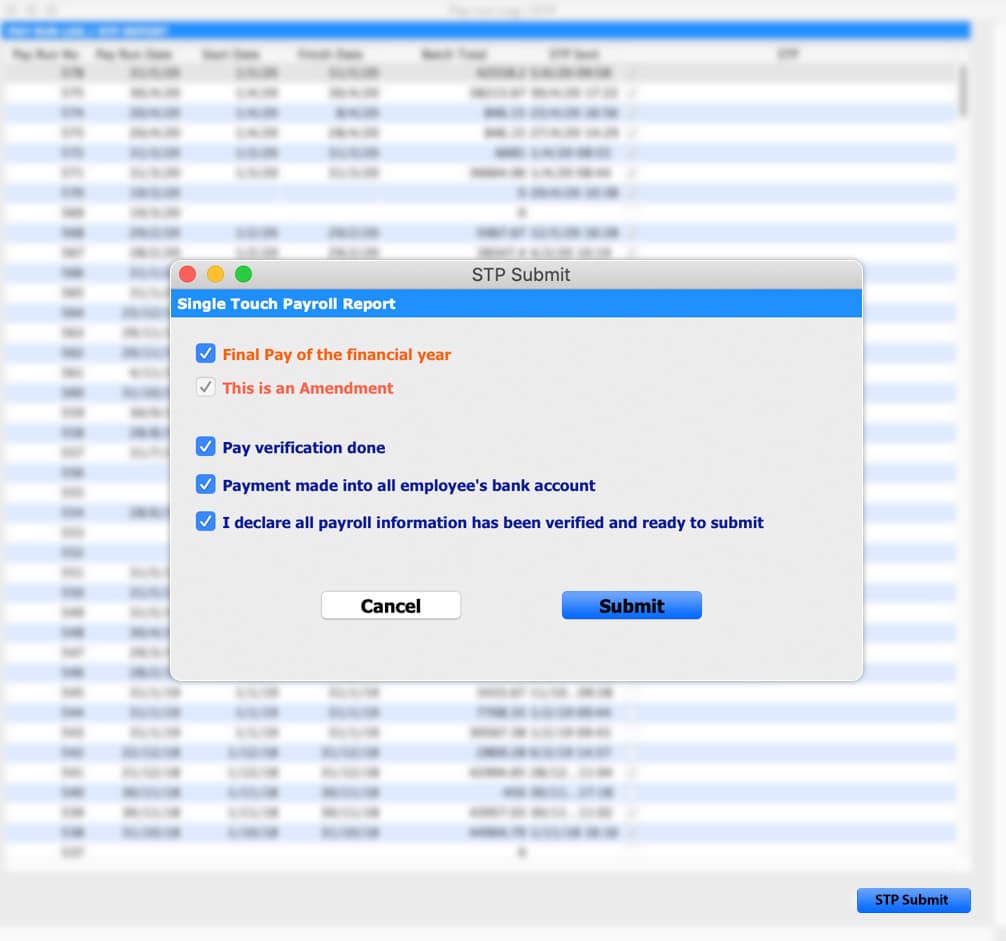
The option of re-submitting the STP Report with opting for “This is an Amendment” only applies for category changes in the Allowance settings (Payment Summary / STP Position).
For example, if you have added an additional allowance in 2019/20 but did not set it as Gross Salary by default, it is set as Not to be Printed and it will not be reported to the ATO. Note that the amendment option is not intended for re-submitting any alterations in your Payroll figures after you have reversed a Pay Run.
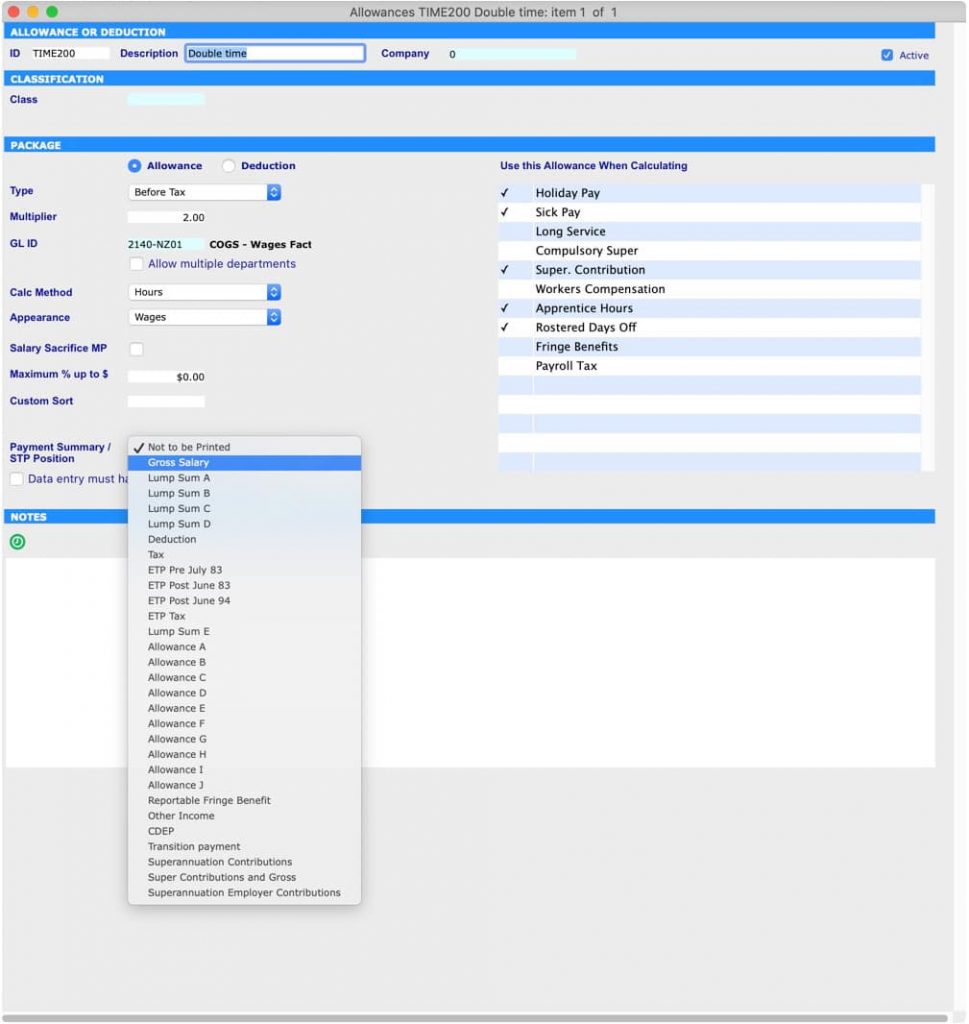
It is very important that you run Period End for Payroll for the last month of your financial year before processing your Payroll Year End, otherwise you will end up in the wrong period!
This means that when running your Payroll Year End, your Payroll will be in period 13. Your last Pay Run for the financial year has to be in period 12 and not in period 1 or period 13.
Important things to remember:
Remember that your Payroll period is different to that of your Financials. When Payroll is in period 12, your General Ledger and other financials may be, as an example, in period 12 or 24.
It is vital that you review your final Pay Run results before you submit your Payroll End of Month as you cannot correct any errors in your data entry afterwards. This is due to the fact that SapphireOne has now implemented a security mechanism preventing Pay Runs to be processed in the wrong financial year. Once you have run Month End to roll from period 12 to period 13, you cannot reverse and re-run Payroll in period 13.
Your Payroll is now all set for processing Year End. As a reminder, verify that your Payroll is, indeed, in period 13 and not still in period 12 or already in period 1.
Go to : Management > Management > End of Year Payroll
Once you have successfully posted your End of Year Payroll, you need to update the periods and taxes for Payroll.
Go to : Utilities > Controls > Select the Company > Page: Periods and Taxes > Select: Payroll > Manually change the Finish Date for Period 1 to the next Payroll year.
For example, as we were in 2019 you will have to set it to 2020 for the current year. By selecting “Auto Fill” (Select: Increment by Month) the year will be adjusted automatically for all other periods in the screen.
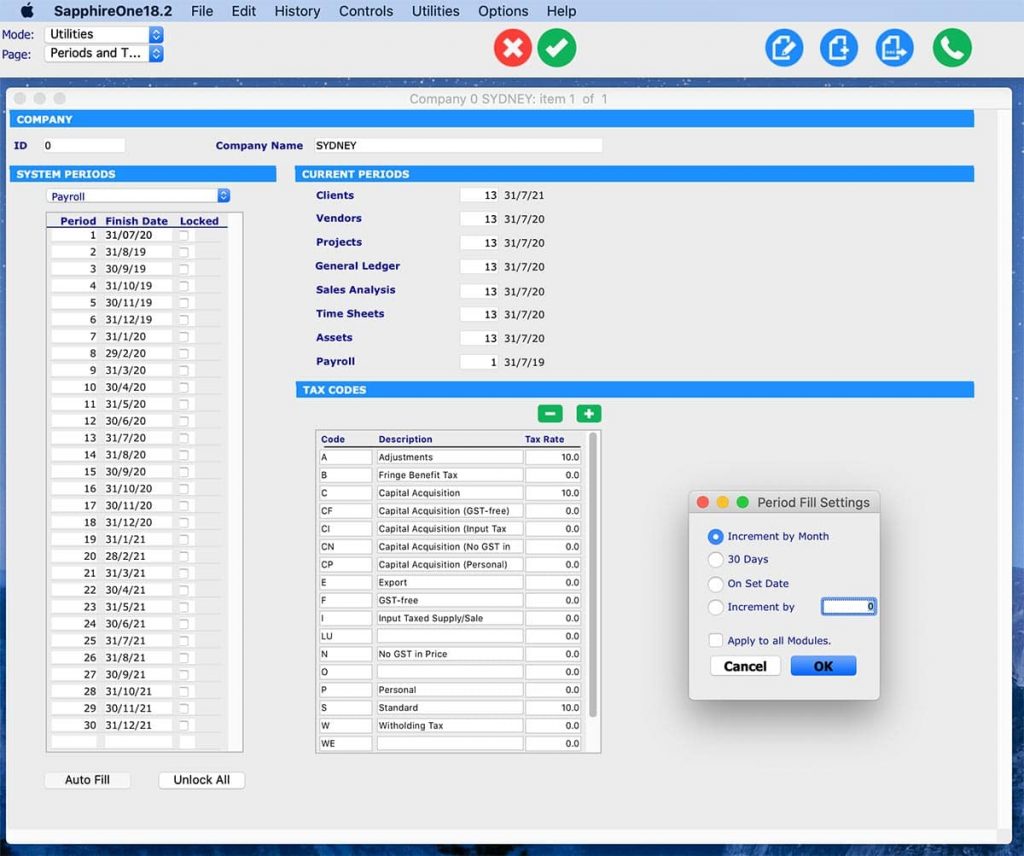
You are almost done! The last step requires you to import the tax scales for Payroll if they have been updated already.
Once the ATO releases the new tax rates, you will receive a reminder email from SapphireOne to make sure that you import them into your system.
Go to : Utilities > Utilities > Sapphire Functions > Dropdown: Payroll >
Then select: ImportTaxRatesTCP (or Text, if required)
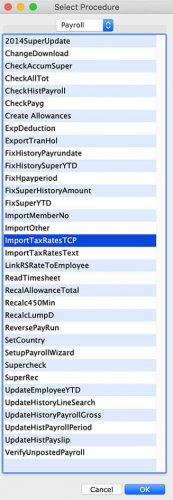
We at SapphireOne are here to support you through the procedures to make sure your Payroll Year End runs smoothly. If you have any questions or need any further assistance, please book a support call and our friendly IT support team will help you out!
Simplify the Financial Reporting Process to Improve Visibility and Allocation of Resources
July 3, 2019 4:17 pm | by John Adams

The financial reporting process to keep internal decision makers and external stakeholders informed is becoming more and more complex every year. Businesses have data coming in from multiple departments and systems, often leaving the financial reporting teams with only half the picture.
Investing in processes through systems and tools can significantly improve their accuracy, process time and results. Automation and software integration benefits the entire business by collating the company data in a single data file, allowing visibility from administration, operations, payroll/HR to finance. Visibility is critical for making informed decisions and allocating finances for resources and project management. Inefficiencies in key financial processes can disrupt operations and cause significant setbacks to your business.
How to simplify your business processes for financial visibility
- Create process maps. This helps to understand how they work and identifies timing and schedules, roles of individuals and teams, functions and organisations, systems and tools, business units, locations etc.
- Once you’ve settled on process maps and highlighted systems to improve, build a management team. This should comprise of a cross-section of dedicated stakeholders who are influential for buy-ins across other departments.
- Examine how to automate your workflows from start to finish to increase efficiency. Once the processes are automated, visibility is increased by having access to real-time data. This helps monitor and analyse performance by identifying inefficiencies and fixing them as they occur. Secure your data by role-based access and look at standardising the recurring and identical processes to simplify replication.
- Identify risks that may result from a breakdown in a process. Investigate how these can be eliminated from multiple data sources, manual steps and any additional steps in a process. Identify opportunities to reduce complexity and increase efficiency through automation, visibility and collaboration.
- Lastly define business rules for decision making. These should be simple and direct so they bypass workflows without delays.
Organise data for a seamless financial reporting process
- Collect and normalise your data by creating flexible templates that enable contributors to submit structured and unstructured data in a consistent fashion. Outline a collection process that facilitates the standardisation of data from all departments. Once the data has been collected, organise the information by developing reporting guidelines, permissions on who can view and edit specific documents, pages, or spreadsheet cells to help preserve data integrity.
- Organise a single source of truth, store your data in one place. This establishes links and an audit trail between source data and all related destinations so any changes are visible and can go through all departments. This ensures, if an error is detected, one person can correct it swiftly and in one place only. Everyone will have the same view and are checking the same data for quality and inconsistencies.
- Store all final reports in a single location. This will simplify the process of searching for the most current data to compile for customised or standard reports, dashboards, workbooks and presentations.
For more information on the benefits for financial management of an ERP System in simplifying the reporting process – SapphireOne ERP, CRM, DMS and Business Accounting Software Application Alternatively, contact our office on (02) 8362 4500 or request a demo.
Why do your organisation needs ERP accounting software?
August 8, 2018 12:22 pm | by John Adams

It is vital for managing all financial aspects of your day to day business activities.
You can perform basic accounting tasks such as generating financial reports, invoicing, tracking income and expenses. Accounting software manages your financial data and analyses sales performance and cashflow which ensures you make informed decisions.
All organisations have to perform a number of tasks to make their company financially successful, ERP Accounting software is an essential investment for any business large or small
SapphireOne ERP CRM DMS Accounting software is designed to help companies introduce accounting accuracy to achieve peak financial performance. SapphireOne ERP CRM DMS is built to comply with international accounting standards and principles, providing comprehensive reporting functionality to assist in reviewing company performance. SapphireOne ERP CRM DMS is a unique accounting software.
Managing Cash Flow
One of the biggest challenges for any business is to manage cash flow efficiently, organisations and business owners need to keep records of all the cash coming in and going out of the business. SapphireOne ERP CRM Accounting software enables business owners to manage their business cash flow management of expenditure and keeps track of the financial status of the company easily.
Invoice Tracking with DMS
Invoice tracking is very important for any organisation’s success. SapphireOne’s in-built document management system (DMS) allows you to attach all supporting documentation by simply clicking on SapphireOne’s paperclip in any related transaction and ensures easy invoice tracking.
Time Saving and Accuracy
SapphireOne ERP Accounting software quickly performs different tasks such as invoicing, sending payment reminders, paying vendors, reconciling bank accounts and generating reports. SapphireOne ERP accounting software provides fast and accurate information. SapphireOne provides a clear and accurate view of the financial standing of your organisation to assist you in managing your business and making informed decisions.
Accounts Receivable
The Accounts Receivable module in SapphireOne’s accounting software is for the entry of all transactions that are involved with Income for the organisation. This may be through Cash Sales or Client Invoices etc. Client accounts are managed efficiently with customer tracking, invoice management, activity analysis, receipt and cash receipt processing.
Accounts Payable
The Accounts Payable module in SapphireOne’s accounting software handles all transactions that are involved with the payment of vendor invoices for the company, this includes the tracking of cash, credit card and eft and other types of payments.
Financial Reporting
SapphireOne ERP CRM DMS accounting software has comprehensive reporting functionality which allows you to analyse all aspects of your financial accounts. Designed with flexibility in mind, SapphireOne reports can be designed to meet your requirements and can be sorted by multiple criteria with numerous levels of details to choose from. Strong reporting tools are essential to your organisation and are fully integrated within the SapphireOne ERP CRM DMS Accounting Software application suite.
For a sneak peek at the full capabilities ERP, CRM, Accounting Software, Human Resources, Payroll, Assets and Document Management, check out SapphireOne and request a live demo, it is everything you’ll ever need to make your company management a success. Know more about us.
Lodge your Tax Return effortlessly and spend time on your big idea
July 13, 2018 10:38 am | by John Adams

At the end of financial year whether you are in Australia, New Zealand or anywhere in the world, all companies have tax obligations. The requirement to produce your Profit & Loss and Balance Sheet at the end of the financial year is mandatory for all businesses and organisations.
A financial year (or fiscal year, or sometimes budget year) is the period used by governments and their tax agencies for accounting and budget purposes, which vary between countries. It is also used for financial reporting by business and other organizations. Laws in many tax jurisdictions/countries require company financial reports to be prepared and published on an annual basis, but generally do not require the reporting period to align with the calendar year. The End of Financial Year (EOFY) is the date that marks the end of the financial year.
The calendar year is used as the financial year by about two thirds of publicly traded companies in the United States and for a majority of large corporations in the UK and elsewhere, with notable exceptions being in Australia, New Zealand and Japan. In Australia the End of Financial year generally falls on June 30th, New Zealand ends their financial year on March 31st. Some organisations and companies follow the USA end their financial year which is often on the same day of the week each year, for example, the Friday closest to 31 December. Under such a system, some fiscal years will have 52 weeks and others 53 weeks.
Taxation laws generally require accounting records to be maintained and taxes calculated annually, which usually corresponds to the financial year used by the government. The calculation of tax on an annual basis is especially relevant for direct taxation, such as company income tax. Many annual government fees and levies—such as Council rates, licence fees, etc. are also calculated on a financial year basis, while others are charged on an anniversary basis.
Many educational institutions have a financial year which ends during the summer to align with the academic year (and, in some cases involving public universities, with the state government’s financial year), and because the university is normally less busy during the summer months. In the northern hemisphere this is July to the next June. In the southern hemisphere this is calendar year, January to December. Some media/communication-based organisations use a broadcast calendar as the basis for their fiscal year.
Whatever the size of your business and tax obligations, you must report and pay any amount due to the ATO, this includes Superannuation and GST, VAT or Sales Tax reporting. It is essential to lodge tax return accurately in order to achieve the maximum business offset and possibly even receive a tax refund.
By managing everything from Financial Reporting, Inventory Control, Assets, Job Projects, Payroll/HR to Bank Reconciliations, SapphireOne ERP CRM DMS can give you more time to do the things that matter, such as developing new strategies and thinking in your business or organisation.
SapphireOne helps you to prepare and lodge tax return
SapphireOne helps you calculate GST and seamlessly lodge your Business Activity Statement (BAS) Standard Business Reporting (SBR2), pay employees and track your PAYG and Superannuation.
SapphireOne ERP CRM DMS can generate comprehensive reports to help you prepare and lodge tax return. Effortless reporting of SapphireOne can help you to get the right data at the right time including Year to Date (YTD) financial reports, PAYG payment summaries, Profit & Loss and Balance Sheet reports.
For a sneak peek at the full capabilities ERP, CRM, Accounting Software, Human Resources, Payroll, Assets and Document Management, check out SapphireOne and request a live demo, it is everything you’ll ever need to make your company management a success. Know more about us.
Simplifying the concept of end of financial year
July 11, 2018 10:34 am | by John Adams

The Australian financial year typically starts from 1st July and ends on 30th June. The 30th June is also known as end of financial year when businesses start preparing their financial reports in order to submit their financial position to the Australian government. In New Zealand the end of financial year is on 31st March, in the United States of America the financial is typically the last Friday of December.
Documents needed for end of financial year
A range of documents are needed to assess the tax obligations of your business such as Income Statement, (also known as the Profit and Loss P&L) and Balance sheet.
The objective of financial statements is to provide information about the financial position, performance and changes in financial position of an enterprise that is useful to a wide range of users in making economic decisions. Financial statements should be understandable, relevant, reliable and comparable. Reported assets, liabilities, equity, income and expenses are directly related to an organization’s financial position.
Countries over time have developed their own accounting methods and principles, making international comparisons of companies difficult. To ensure comparability and uniformity between financial statements prepared by different companies, a set of guidelines and rules are used. Commonly referred to as Generally Accepted Accounting Principles (GAAP), these set of guidelines provide the basis in the preparation of financial statements.
SapphireOne ERP CRM DMS can support unlimited number of companies in unlimited tax jurisdictions in one data file. SapphireOne also support multiple foreign currencies and unlimited number of foreign bank accounts, supporting all your foreign exchange (FX) requirements.
Income statement / Profit and Loss (P & L)
The Income Statement or Profit and Loss (P & L) measures a company’s income and expenses during a specified period of time. A profit and loss statement provides information on the operation of the enterprise. These include sales and the various expenses incurred during the stated period.
The Income Statement is one of the most important financial statements a business or organisation issues annually, along with the balance sheet and the cash-flow statement.
SapphireOne ERP CRM DMS has the ability to run the current year versus last year reports, or if required up to ten years historical data on the one report.
SapphireOne also has the ability to copy last year’s actual general ledger balances into the current year’s budget.
Balance sheet
The company Balance Sheet represents company’s financial position, which is important at the end of financial year. The Balance Sheet outlines the total assets, liabilities and owner’s or stockholders’ equity at a specified point in time. Assets the business owns, such as vehicles, plant and equipment, property, intellectual property and cash in the bank are included on the Balance Sheet, depreciation of these assets is included on the Income Statement (P&L). Liabilities include your creditors, payroll obligations such as employee’s annual, carer and long-service accrued leave.
SapphireOne ERP CRM DMS financial reporting has the ability to export data to spreadsheet and also import data to the general ledger budget via the Sapphire API gateway.
For a sneak peek at the full capabilities ERP, CRM, Accounting Software, Human Resources, Payroll, Assets and Document Management, check out SapphireOne and request a live demo, it is everything you’ll ever need to make your company management a success. Know more about us.
